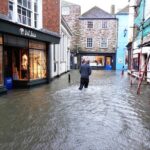
The unexpected challenge of water damage in hotels is right in the middle of the hospitality industry. Plumbing errors, floods, and leaks can all ruin the smooth experience that guests expect. Water damage repair is more than just a maintenance job; it is a commitment to making sure everyone is comfortable and safe.
This comprehensive guide will cover all the necessary tricks and specific actions to handle water damage in hotels. From quick fixes to long-term solutions, every section offers insightful advice to help hotel managers and employees continue to provide the best possible guest experiences.
The essence of hospitality is preserved even in the face of unforeseen setbacks, and as such, hotels serve as more than just structures—they are temporary havens for weary travelers seeking solace and comfort. Water damage disturbs this sanctuary, and our approach to dealing with it needs to be focused on maintaining the guest experience.
See also our post on A Comprehensive Guide on Preventing Water Damage in Drought-Prone Areas
Immediate Responses to Water Incidents
Swift and decisive actions in the aftermath of water incidents are paramount to minimizing damage and maintaining guest satisfaction.
Quick Intervention Strategies:
- Identify and Stop the Source: Immediately identify the source of the water damage, whether it’s a burst pipe, leaking roof, or faulty appliance. Take swift action to stop the water flow or address the root cause.
- Prioritize Guest Safety: If guests are in immediate danger, prioritize their safety by guiding them to secure areas away from the water-affected zones. Clear evacuation routes and provide assistance as needed.
- Contact Maintenance Team: Alert the maintenance team promptly. Their expertise is crucial in assessing the extent of the damage and implementing immediate measures to contain and address the issue.
- Deploy Emergency Equipment: Use emergency equipment such as wet-dry vacuums, mops, and buckets to start removing standing water. This prevents further spreading and limits the damage.
- Document the Damage: Take photographs or videos of the affected areas for insurance purposes. Documenting the initial condition is essential for a smoother claims process.
Assessing Water Damage Extent
Understanding the scope of water damage is fundamental to formulating an effective restoration plan.
Thorough Damage Assessment:
- Engage Professional Assessors: Bring in professional assessors to thoroughly examine the extent of water damage. Their expertise ensures a comprehensive evaluation, identifying hidden issues that may not be immediately apparent.
- Categorize Water Damage: Classify the water damage based on categories (clean water, gray water, black water) and classes (the extent of damage). This categorization guides the appropriate restoration methods and safety precautions.
- Check Structural Integrity: Assess the structural integrity of affected areas. Identify any compromised structures or materials that may pose risks to guests or staff.
- Evaluate Electrical Systems: Evaluate the impact of water damage on electrical systems. Exercise caution and, if necessary, disconnect power to affected areas to prevent electrical hazards.
- Compile Assessment Report: Generate a detailed assessment report that includes damage categories, affected areas, and recommended actions. This report serves as a crucial reference for the restoration process.
Swift Water Removal Techniques
Efficient water removal techniques are essential to prevent further damage and expedite the restoration process.
Water Extraction Strategies:
- Utilize Industrial-Grade Extractors: Invest in industrial-grade water extractors for efficient removal of standing water. These powerful machines swiftly extract large volumes, expediting the drying process.
- Implement Wet-Vacuuming: Wet-vacuuming is effective for smaller-scale water removal. Use portable wet-dry vacuums to extract water from carpets, upholstery, and other affected surfaces.
- Employ Submersible Pumps: Submersible pumps are valuable for large-scale water removal, especially in areas like basements or pools. They efficiently pump out water to prevent further damage.
- Promote Natural Drying: Maximize natural ventilation to aid in the drying process. Open windows and doors to encourage air circulation, facilitating the evaporation of residual moisture.
- Coordinate with Restoration Professionals: Engage restoration professionals to oversee the water removal process. Their expertise ensures that water is thoroughly extracted, minimizing the risk of mold growth and long-term damage.
Drying and Dehumidification Techniques
Drying out affected areas is a critical phase in preventing mold growth and restoring normalcy.
Efficient Drying Strategies:
- Use Commercial-Grade Dehumidifiers: Deploy commercial-grade dehumidifiers to extract excess moisture from the air. This helps accelerate the drying process and prevents the proliferation of mold.
- Position Air Movers Strategically: Place air movers strategically to enhance air circulation. These powerful fans expedite evaporation, especially in confined spaces or areas with limited ventilation.
- Focus on Carpet and Upholstery Drying: Pay special attention to drying carpets and upholstery. Utilize carpet fans and dehumidifiers to prevent lingering moisture, which can lead to mold and unpleasant odors.
- Monitor Humidity Levels: Regularly monitor humidity levels in the affected areas. Adjust the settings on dehumidifiers to maintain optimal conditions for efficient drying.
- Use Desiccant Dehumidifiers for Specialty Areas: In specialized areas such as document storage or electronic rooms, consider using desiccant dehumidifiers. These units provide precise control over humidity levels, protecting sensitive materials.
Restoration of Damaged Structures and Materials
Restoring damaged structures and materials requires a systematic and thorough approach.
Comprehensive Restoration Steps:
- Address Structural Repairs: Prioritize structural repairs to ensure the safety and stability of affected areas. Engage professional contractors to assess and address any structural damage.
- Replace Damaged Insulation: Water-damaged insulation can compromise energy efficiency and contribute to mold growth. Replace affected insulation promptly to restore the hotel’s environmental controls.
- Repair or Replace Flooring: Assess the condition of flooring materials, such as carpets or hardwood. Depending on the extent of damage, either repair or replace these materials to maintain a clean and welcoming environment.
- Restore Furnishings and Fixtures: Salvage and restore furnishings and fixtures whenever possible. Engage professional restoration services to clean, disinfect, and refurbish damaged items.
- Paint and Seal Surfaces: Repaint and seal surfaces to restore aesthetic appeal and provide an additional layer of protection against future water damage. Choose moisture-resistant paints and sealants for added durability.
Communication and Guest Relations
Open and transparent communication is key in managing water damage incidents and maintaining guest satisfaction.
Effective Communication Strategies:
- Notify Guests Promptly: If water damage affects guest accommodations, notify guests promptly and transparently. Clearly communicate the situation, relocation plans, and any compensation or alternative arrangements.
- Provide Regular Updates: Keep guests informed with regular updates on the restoration progress. Transparency builds trust and demonstrates a commitment to resolving the situation.
- Train Staff for Guest Interactions: Train staff to handle guest interactions with empathy and professionalism. Equip them with accurate information to address guest concerns and inquiries effectively.
- Offer Compensation as Appropriate: Depending on the severity of the inconvenience, consider offering compensation or amenities as a gesture of goodwill. This helps mitigate dissatisfaction and fosters positive guest relations.
- Implement Guest Feedback Mechanisms: Establish mechanisms for guests to provide feedback on their experience during and after the restoration process. Valuable insights can inform future improvements in water damage response protocols.
Preventive Measures for Future Preparedness
Learning from water damage incidents is an opportunity to implement robust preventive measures for future preparedness.
Proactive Preventive Strategies:
- Conduct Regular Inspections: Implement routine inspections to identify and address potential water damage risks before they escalate. Regular checks of plumbing, roofing, and structural elements are essential.
- Install Leak Detection Systems: Invest in advanced leak detection systems to identify water leaks at their inception. These systems can provide early warnings, allowing for swift intervention.
- Upgrade Plumbing and Roofing: Consider upgrading plumbing and roofing systems to modern, water-resistant materials. This proactive approach minimizes the risk of water damage from aging infrastructure.
- Employee Training for Emergency Response: Train hotel staff for effective emergency response. Equip them with the skills to identify and address water damage incidents promptly.
- Collaborate with Restoration Professionals: Establish partnerships with reputable restoration professionals. Having a trusted team on standby ensures a swift and coordinated response in the event of water damage.
See also our post on A Comprehensive Guide on How to Save Musical Instruments from Water Damage
Conclusion
More than just a challenge, water damage in hotels is an opportunity to demonstrate resiliency and dedication to guest satisfaction. Every action listed in this extensive guide, from preventive measures to immediate responses, adds to the overall effectiveness and preparedness of handling water damage incidents.
Recall that, as stewards of hospitality, your commitment to a flawless visitor experience includes handling unforeseen circumstances with poise and effectiveness. By adopting these tactics, you lessen the effects of water damage while also enhancing the perception of your hotel as a sanctuary of care and comfort.






